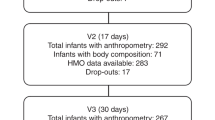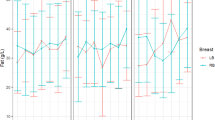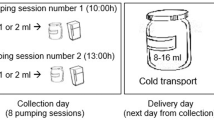Abstract
Background/Objectives:
The objective of this study was to quantify human milk supply and intake of breastfed infants up to age 12 months. In addition, human milk composition was quantified per energetic macronutrient and fatty-acid composition in a subsample of lactating mothers.
Subjects/Methods:
One hundred and seventy-four Italian breastfed children were followed using test-weighing and 3-day food protocols from birth to age 12 months. From a subsample of 30 mothers breast milk samples were collected at child ages one (T1), two (T2), three (T3) and six (T6) months, and were analyzed for the amount of protein, digestible carbohydrates, total lipids and fatty-acid composition.
Results:
One hundred and forty-two (82%) filled in at least one 3-day food protocol within the first 12 months of life and complied with test-weighing of all milk feeds. The number of valid food protocols declined from 126 infants at 1 month to 77 at 12 months of age. Only galactose, non-protein nitrogen and protein decreased significantly from age 1 to age 6 months of lactation. Maternal body mass index and age affected fatty-acid levels in human milk. Median human milk intake decreased from 625 ml at T1, over 724 ml at T3 to 477 ml/day at T6. Average energy and %energy from protein intake per day increased from 419 kcal (s.d. 99) and 8.4% (1.0) at T1, respectively, to 860 kcal (145) and 16.1% (2.6) at T12.
Conclusions:
These data provide a reference range of nutrient intakes in breastfed infants and may provide guidance for defining optimal nutrient intakes for infants that cannot be fully breastfed.
This is a preview of subscription content, access via your institution
Access options
Subscribe to this journal
Receive 12 print issues and online access
$259.00 per year
only $21.58 per issue
Buy this article
- Purchase on Springer Link
- Instant access to full article PDF
Prices may be subject to local taxes which are calculated during checkout


Similar content being viewed by others
References
Agostoni C, Decsi T, Fewtrell M, Goulet O, Kolacek S, Koletzko B et al. Complementary feeding: a commentary by the ESPGHAN Committee on Nutrition. J Pediatr Gastroenterol Nutr 2008; 46: 99–110.
Nutrition ECo, Agostoni C, Braegger C, Decsi T, Kolacek S, Koletzko B et al. Breast-feeding: a commentary by the ESPGHAN Committee on Nutrition. J Pediatr Gastroenterol Nutr 2009; 49: 112–125.
Hermoso M, Tabacchi G, Iglesia-Altaba I, Bel-Serrat S, Moreno-Aznar LA, Garcia-Santos Y et al. The nutritional requirements of infants. Towards EU alignment of reference values: the EURRECA network. Matern Child Nutr 2010; 6: 55–83.
Koletzko B, Baker S, Cleghorn G, Neto UF, Gopalan S, Hernell O et al. Global standard for the composition of infant formula: recommendations of an ESPGHAN coordinated international expert group. J Pediatr Gastroenterol Nutr 2005; 41: 584–599.
Koletzko B, Bhutta ZA, Cai W, Cruchet S, El Guindi M, Fuchs GJ et al. Compositional requirements of follow-up formula for use in infancy: recommendations of an international expert group coordinated by the Early Nutrition Academy. Ann Nutr Metab 2013; 62: 44–54.
Heinig MJ, Nommsen LA, Peerson JM, Lonnerdal B, Dewey KG . Energy and protein intakes of breast-fed and formula-fed infants during the first year of life and their association with growth velocity: the DARLING Study. Am J Clin Nutr 1993; 58: 152–161.
Ferris AM, Dotts MA, Clark RM, Ezrin M, Jensen RG . Macronutrients in human milk at 2, 12, and 16 weeks postpartum. J Am Diet Assoc 1988; 88: 694–697.
Butte NF, Garza C, Johnson CA, Smith EO, Nichols BL . Longitudinal changes in milk composition of mothers delivering preterm and term infants. Early Hum Dev 1984; 9: 153–162.
Neville MC, Allen JC, Archer PC, Casey CE, Seacat J, Keller RP et al. Studies in human lactation: milk volume and nutrient composition during weaning and lactogenesis. Am J Clin Nutr 1991; 54: 81–92.
Allen JC, Keller RP, Archer P, Neville MC . Studies in human lactation: milk composition and daily secretion rates of macronutrients in the first year of lactation. Am J Clin Nutr 1991; 54: 69–80.
Marangoni F, Agostoni C, Lammardo AM, Giovannini M, Galli C, Riva E . Polyunsaturated fatty acid concentrations in human hindmilk are stable throughout 12-months of lactation and provide a sustained intake to the infant during exclusive breastfeeding: an Italian study. Br J Nutr 2000; 84: 103–109.
Agostoni C, Riva E, Scaglioni S, Marangoni F, Radaelli G, Giovannini M . Dietary fats and cholesterol in italian infants and children. Am J Clin Nutr 2000; 72: 1384S–1391S.
Koletzko B, von Kries R, Closa R, Escribano J, Scaglioni S, Giovannini M et al. Lower protein in infant formula is associated with lower weight up to age 2 y: a randomized clinical trial. Am J Clin Nutr 2009; 89: 1836–1845.
Schiess S, Grote V, Scaglioni S, Luque V, Martin F, Stolarczyk A et al. Introduction of complementary feeding in 5 European countries. J Pediatr Gastroenterol Nutr 2010; 50: 92–98.
WHO MGRSG. WHO Child Growth Standards based on length/height, weight and age. Acta Paediatr Suppl 2006; 450: 76–85.
Shank RE, Hoagland CL . A modified method for the quantitative determination of the thymol turbidity reaction of serum. J Biol Chem 1946; 162: 133–138.
Kowalski ZE, Giesecke WH . A high performance liquid chromatographic method for the fluorimetric determination of lactose, galactose and glucose in normal and abnormal milk of cows. Onderstepoort J Vet Res 1986; 53: 225–229.
Folch J, Lees M, Sloane Stanley GH . A simple method for the isolation and purification of total lipides from animal tissues. J Biol Chem 1957; 226: 497–509.
Rouser G, Siakotos AN, Fleischer S . Quantitative analysis of phospholipids by thin-layer chromatography and phosphorus analysis of spots. Lipids 1966; 1: 85–86.
Verwied-Jorky S, Schiess S, Luque V, Grote V, Scaglioni S, Vecchi F et al. Methodology for longitudinal assessment of nutrient intake and dietary habits in early childhood in a transnational multicenter study. J Pediatr Gastroenterol Nutr 2011; 52: 96–102.
Atkinson SA, Koletzko B . Determining life-stage groups and extrapolating nutrient intake values (NIVs). Food Nutr Bull 2007; 28: S61–S76.
Nommsen LA, Lovelady CA, Heinig MJ, Lonnerdal B, Dewey KG . Determinants of energy, protein, lipid, and lactose concentrations in human milk during the first 12 mo of lactation: the DARLING Study. Am J Clin Nutr 1991; 53: 457–465.
Michaelsen KF, Larsen PS, Thomsen BL, Samuelson G . The Copenhagen Cohort Study on Infant Nutrition and Growth: breast-milk intake, human milk macronutrient content, and influencing factors. Am J Clin Nutr 1994; 59: 600–611.
Khan S, Hepworth AR, Prime DK, Lai CT, Trengove NJ, Hartmann PE . Variation in fat, lactose, and protein composition in breast milk over 24 hours: associations with infant feeding patterns. J Hum Lact 2013; 29: 81–89.
Quinn EA, Largado F, Power M, Kuzawa CW . Predictors of breast milk macronutrient composition in Filipino mothers. Am J Hum Biol 2012; 24: 533–540.
Bauer J, Gerss J . Longitudinal analysis of macronutrients and minerals in human milk produced by mothers of preterm infants. Clin Nutr 2011; 30: 215–220.
Coppa GV, Gabrielli O, Pierani P, Catassi C, Carlucci A, Giorgi PL . Changes in carbohydrate composition in human milk over 4 months of lactation. Pediatrics 1993; 91: 637–641.
Cavalli C, Teng C, Battaglia FC, Bevilacqua G . Free sugar and sugar alcohol concentrations in human breast milk. J Pediatr Gastroenterol Nutr 2006; 42: 215–221.
Antonakou A, Skenderi KP, Chiou A, Anastasiou CA, Bakoula C, Matalas AL . Breast milk fat concentration and fatty acid pattern during the first six months in exclusively breastfeeding Greek women. Eur J Nutr 2013; 52: 963–973.
Saarela T, Kokkonen J, Koivisto M . Macronutrient and energy contents of human milk fractions during the first six months of lactation. Acta Paediatr 2005; 94: 1176–1181.
Michaelsen KF, Skafte L, Badsberg JH, Jorgensen M . Variation in macronutrients in human bank milk: influencing factors and implications for human milk banking. J Pediatr Gastroenterol Nutr 1990; 11: 229–239.
Jensen RG . Lipids in human milk. Lipids 1999; 34: 1243–1271.
Stam J, Sauer PJ, Boehm G . Can we define an infant's need from the composition of human milk? Am J Clin Nutr 2013; 98: 521S–528S.
Koletzko B, Thiel I, Abiodun PO . The fatty acid composition of human milk in Europe and Africa. J Pediatr 1992; 120: S62–S70.
EFSA NDA . Panel (EFSA Panel on Dietetic Products NaA. Scientific Opinion on Dietary Reference Values for fats, including saturated fatty acids, polyunsaturated fatty acids, monounsaturated fatty acids, trans fatty acids, and cholesterol. EFSA J 2010; 8: 1461.
EFSA NDA . Panel (EFSA Panel on Dietetic Products NaA. Scientific Opinion on the essential composition of infant and follow-on formulae. EFSA J 2014; 12: 3760.
Smit EN, Koopmann M, Boersma ER, Muskiet FA . Effect of supplementation of arachidonic acid (AA) or a combination of AA plus docosahexaenoic acid on breastmilk fatty acid composition. Prostaglandins Leukot Essent Fatty Acids 2000; 62: 335–340.
Patin RV, Vitolo MR, Valverde MA, Carvalho PO, Pastore GM, Lopez FA . The influence of sardine consumption on the omega-3 fatty acid content of mature human milk. J Pediatr (Rio J) 2006; 82: 63–69.
Olafsdottir AS, Thorsdottir I, Wagner KH, Elmadfa I . Polyunsaturated fatty acids in the diet and breast milk of lactating icelandic women with traditional fish and cod liver oil consumption. Ann Nutr Metab 2006; 50: 270–276.
Emken EA, Adlof RO, Hachey DL, Garza C, Thomas MR, Brown-Booth L . Incorporation of deuterium-labeled fatty acids into human milk, plasma, and lipoprotein phospholipids and cholesteryl esters. J Lipid Res 1989; 30: 395–402.
Reilly JJ, Ashworth S, Wells JCK . Metabolisable energy consumption in the exclusively breast-fed infant aged 3-6 months from the developed world: a systematic review. Br J Nutr 2005; 94: 56–63.
da Costa TH, Haisma H, Wells JC, Mander AP, Whitehead RG, Bluck LJ . How much human milk do infants consume? Data from 12 countries using a standardized stable isotope methodology. J Nutr 2010; 140: 2227–2232.
EFSA NDA . Panel (EFSA Panel on Dietetic Products NaA. Scientific opinion on nutrient requirements and dietary intakes of infants and young children in the European Union. EFSA J 2013; 11: 3408.
IoM (Institute of Medicine) Dietary reference intakes for energy, carbohydrate, fiber, fat, fatty acids, cholesterol, protein, and amino acids. National Academies Press: Washington DC, USA, 2005.
Alexy U, Kersting M, Sichert-Hellert W, Manz F, Schoch G . Macronutrient intake of 3- to 36-month-old German infants and children: results of the DONALD Study. Dortmund Nutritional and Anthropometric Longitudinally Designed Study. Ann Nutr Metab 1999; 43: 14–22.
Agostoni C, Scaglioni S, Ghisleni D, Verduci E, Giovannini M, Riva E . How much protein is safe? Int J Obes 2005; 29: S8–S13.
Weber M, Grote V, Closa-Monasterolo R, Escribano J, Langhendries JP, Dain E et al. Lower protein content in infant formula reduces BMI and obesity risk at school age: follow-up of a randomized trial. Am J Clin Nutr 2014; 99: 1041–1051.
Koletzko B, Lien E, Agostoni C, Bohles H, Campoy C, Cetin I et al. The roles of long-chain polyunsaturated fatty acids in pregnancy, lactation and infancy: review of current knowledge and consensus recommendations. J Perinat Med 2008; 36: 5–14.
Koletzko B, Boey CC, Campoy C, Carlson SE, Chang N, Guillermo-Tuazon MA et al. Current information and Asian perspectives on long-chain polyunsaturated fatty acids in pregnancy, lactation, and infancy: systematic review and practice recommendations from an early nutrition academy workshop. Ann Nutr Metab 2014; 65: 49–80.
Fidler N, Sauerwald T, Pohl A, Demmelmair H, Koletzko B . Docosahexaenoic acid transfer into human milk after dietary supplementation: a randomized clinical trial. J Lipid Res 2000; 41: 1376–1383.
Acknowledgements
The studies reported herein have been carried out with partial financial support from the Commission of the European Community, specific RTD Programme ‘Quality of Life and Management of Living Resources’, within the 5th Framework Programme, research grants no. QLRT–2001–00389 and QLK1-CT-2002-30582, and the 6th Framework Programme, contract no. 007036 and the European Union's Seventh Framework Programme (FP7/2007-2013), project EarlyNutrition under grant agreement no. 289346. This manuscript does not necessarily reflect the views of the Commission and in no way anticipates the future policy in this area. The formula for the study was produced by Bledina (Villefranche-sur-Saône Cédex, France, part of Danone Baby Nutrition), who operated as a partner of this EU project and received a grant from the EU Commission for this task. No funding bodies had any role in study design, data collection and analysis, decision to publish or preparation of the manuscript.
Author information
Authors and Affiliations
Consortia
Corresponding author
Ethics declarations
Competing interests
The authors declare no conflict of interest.
Rights and permissions
About this article
Cite this article
Grote, V., Verduci, E., Scaglioni, S. et al. Breast milk composition and infant nutrient intakes during the first 12 months of life. Eur J Clin Nutr 70, 250–256 (2016). https://doi.org/10.1038/ejcn.2015.162
Received:
Revised:
Accepted:
Published:
Issue Date:
DOI: https://doi.org/10.1038/ejcn.2015.162
This article is cited by
-
Regenerative Potential of Human Breast Milk: A Natural Reservoir of Nutrients, Bioactive Components and Stem cells
Stem Cell Reviews and Reports (2023)
-
Health Risk of Infants Exposed to Lead and Mercury Through Breastfeeding
Exposure and Health (2023)
-
Disparity in prevalence and predictors of undernutrition in children under five among agricultural, pastoral, and agro-pastoral ecological zones of Karamoja sub-region, Uganda: a cross sectional study
BMC Pediatrics (2022)
-
Revised D-A-CH reference values for the intake of biotin
European Journal of Nutrition (2022)
-
Prebiotic ice cream containing human milk discarded by human milk banks: an approach of its technological properties and composition
Journal of Food Measurement and Characterization (2022)



